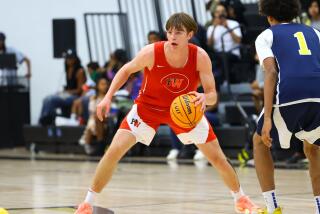Matadors Start at Top of Big Sky
NORTHRIDGE — Lifting off into the Big Sky Conference is becoming a New Year’s tradition for Cal State Northridge, and the Matadors are prepared to do so more resolutely than ever, beginning with the opener tonight at Northern Arizona.
Their first two seasons in the nine-team conference were a mix of surprising victories against established teams and frustrating inconsistency that resulted in a seventh-place finish last season and a sixth-place finish in 1996-97.
Even though the Matadors (8-4) have doubled their nonconference victory total of the last two seasons, the third time’s still a challenge.
“Our conference has done well in the preseason and three or four teams legitimately could win the championship,” said Bobby Braswell, third-year coach at Northridge.
“To win, we must be ready to play hard every night and beat good teams on the road.”
Many of the weaknesses that kept Northridge from becoming a top-echelon Big Sky team have been addressed.
* Point guard: Freshman Markus Carr is a better ballhandler and defensive player than his predecessors, although neither Carr nor Jason Crowe, the other point guard, shoot well from outside.
Carr and Crowe have combined for 46 steals and 97 assists while committing 57 turnovers.
“Both guys get overeager and try to force some things, but they also make plays we’ve never made in the past,” Braswell said.
* Go-to shooters: Last season nobody seemed to want the ball down the stretch in close games. That should no longer be the case with the emergence of center Brian Heinle as a scoring threat and willing shooters such as forwards Rico Harris and Andre Larry, and guards Greg Minor and Carl Holmes.
* Rebounding and interior defense: Getting bullied on the boards remains a problem against top opponents despite the addition of Harris and forward Hewitt Rolle, and the improvement of Heinle and forward Jeffrey Parris.
Although nobody averages more than six rebounds a game, Northridge has outrebounded opponents, 463-447.
Heinle is much better defensively and a healthy Derrick Higgins, perhaps the best defender in the conference, has made a huge difference. Northridge opponents are shooting 45% and have taken 60 fewer shots than the Matadors.
* Officiating: Whistle-happy Big Sky referees put a damper on the Matadors’ pressure man-to-man defense last season and there is no reason to believe that will change.
However, the Matadors refuse to compromise a defensive philosophy that has resulted in forcing an average of 24 turnovers with more than 12 steals per game.
“I’m excited about taking this team through the Big Sky schedule,” Braswell said. “These guys work extremely hard and we match up well talent-wise with [the competition].
“My first year we didn’t have the talent, and last year we didn’t have the right attitudes. This time we have a rotation of nine or 10 guys who believe in the system and play unselfishly.”
A look at the Big Sky:
Northern Arizona (21-8 overall last season, 13-3 in Big Sky play)--The defending conference champion Lumberjacks lost only one player of impact--Andrew Mavis, the leading scorer at 14 points. Everyone else returns from a team that stormed to the conference tournament championship and pushed Cincinnati before losing in the first round of the NCAA Tournament.
The Lumberjacks were among the nation’s leaders in three-point shooting and field-goal percentage last season, and again are potent with guard Ross Land, who has made 31 of 59 three-pointers.
Northern Arizona (8-3) is strong inside with center Dan McLintock shooting 67.9% and forward Casey Frank averaging 7.3 rebounds.
Point guard Kawika Akina had 13 assists and 15 points against St. Bonaventure on Dec. 18, helping Northern Arizona to the championship game of the Nike Festival in Hawaii.
Weber State (14-13, 12-4)--Last season, the Wildcats were 4-8 heading into conference play but rallied to finish second. Weber State’s nonconference record is 9-4 and two talented newcomers join returning starters Andy Jensen, Eric Ketcham and Damien Baskerville.
Jensen, a 6-7, 230-pound senior, was Big Sky player of the week after making 12 of 18 shots and grabbing 13 rebounds in a victory over Seattle and an upset of Utah State last week. Jensen is shooting 69.5%, best in the conference.
Harold Arceneaux, a 6-6 forward, has emerged as the top scorer. The transfer from Midland, Texas, averages 20.6 points and has scored 69 more points than any other Big Sky player. Point guard Eddie Gill averages 11.2 points, four assists and trails only Derrick Higgins of Northridge in steals among Big Sky players.
Portland State (15-12, 10-6)--The Vikings (7-3) are eligible for the Big Sky and NCAA tournaments for the first time since resurrecting their program in 1996.
Jason Hartman, a senior forward from Thousand Oaks High and Washington, and Brian Towne, also a transfer from Washington, are the most dangerous weapons. Hartman, the Big Sky’s newcomer of the year last season, averages 20.5 points and Towne averages 13.6.
Derek Nesland, averaging 11.6 points, and junior college transfer Reggie Ball, at 10.6, give the Vikings four scoring threats.
Eastern Washington (16-11, 10-6)--Injuries and the loss of All-Big Sky forward Karim Scott to graduation have slowed the Eagles (4-7).
Shannon Taylor, a senior guard from Ventura College, averages 12.9 points although he is shooting only 33.1%, and Deon Williams, All-Big Sky point guard, averages 10.9 points and five assists.
Alex Carcamo, a 6-7 forward from Santa Monica City College, will be eligible for the first time in the Big Sky opener.
Montana (16-14, 9-7)--Despite losing their best two players to graduation, the Grizzlies (7-4) are riding a five-game winning streak.
Matt Williams, a 6-7 forward who grew up in Santa Barbara, averages 14.5 points and leads the conference with a rebounding average of 9.5.
Guard Mike Warhank, a reserve last season, averages 11.6 points and has made 85% of his free throws.
Montana State (19-11, 9-7)--The Bobcats took a 9-3 record into conference play last season before fading to a sixth-place finish. This season’s 6-5 record probably won’t deceive opponents because everybody knows Montana State possesses perhaps the Big Sky’s best inside threat, Nate Holmstadt, and best outside threat, Danny Sprinkle.
Holmstadt, a 6-8, 255-pound center, leads the conference with a 22.1 scoring average.
Sprinkle, a 6-2 senior guard, averages 15.2 points and leads the conference with an 85.7% free-throw percentage. He is the Big Sky’s all-time leader in three-point baskets.
Idaho State (6-20, 2-14)--The Bengals (2-8) do not appear to have improved much under first-year Coach Doug Oliver. Tywan Meadows, who averaged 20.9 points, is gone and three returning starters average a combined 15 points.
Newcomer Kevin Sweetwyne averages 15.3 points despite shooting 33.9%. Senior Odell Stokes averages 8.5 rebounds.
Sacramento State (1-25, 0-16)--One of the worst teams in Division I is showing no signs of getting better, with an 0-10 record and only lucrative guarantees for playing at Minnesota, New Mexico and Fresno State to show for it.
Sean Houston, who averaged 14.4 points and 10.7 rebounds last season, is sharing the load with Anthony Flood, a transfer from Sierra College. Flood averages 12.8 points and Houston averages 9.6 pints and 6.8 rebounds.
Freshman point guard Nate Murase is averaging 5.3 assists while sharing playing time with Ryan Coleman, a sophomore returning starter from Calabasas High.


